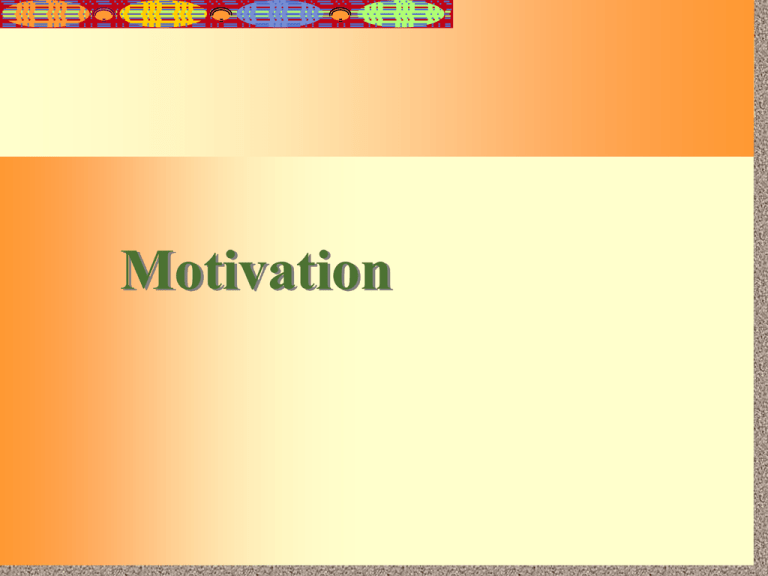Motivation 12-1
advertisement

12-1 Motivation 12-2 Motivation Defined as the psychological forces within a person that determine: 1) direction of behavior in an organization; 2) the effort or how hard people work; 3) the persistence displayed in meeting goals. Intrinsic Motivation: behavior performed for its own sake. Motivation comes from performing the work. Extrinsic Motivation: behavior performed to acquire rewards. Motivation source is the consequence of an action. 12-3 Outcomes & Inputs Regardless of the source of motivation, people seek outcomes. Outcome: anything a person gets from a job. Organizations hire workers to obtain inputs: Input: anything a person contributes to their job. Examples include pay, autonomy, accomplishment. Examples include skills, knowledge, work behavior. Managers thus use outcomes to motivate workers to provide inputs. 12-4 Motivation Equation Figure 12.1 Inputs from Organizational members Performance Outcomes received by members Time Effort Education Experience Skills Knowledge Work Behav. Contribute to organization efficiency, effectiveness and attain goals Pay Job Security Benefits Vacation Autonomy Responsibility 12-5 Expectancy Theory Developed by Victor Vroom and is a very popular theory of work motivation. Vroom suggests that motivation will be high when workers feel: High levels of effort lead to high performance. High performance will lead to the attainment of desire outcomes. Consists of three areas: Expectancy, Instrumentality, & Valence. 12-6 Expectancy, Instrumentality, & Valence Figure 12.2 Effort Expectancy: Person’s perception that their effort will result in performance Performance Instrumentality perception that performance results in outcomes Outcomes Valence: How desired are the outcomes from a job 12-7 Expectancy, Instrumentality, & Valence Expectancy is the perception that effort (input) will result in a level of performance. You will work hard if it leads to high performance. You would be less willing to work hard if you knew that the best you would get on a paper was a D regardless of how hard you tried. Instrumentality: Performance leads to outcomes. Workers are only motivated if they think performance leads to an outcome. Managers should link performance to outcomes. Valence: How desirable each outcome is to a person. Managers should determine the outcomes workers want most. 12-8 High Motivation: According to the Expectancy Theory, high motivation results from high levels of Expectancy, Instrumentality, & Valence. If just one value is low, motivation will be low. This means that even if desired outcomes are closely link to performance, the worker must feel the task is possible to achieve for high motivation to result. Managers need to consider this relationship to build a high performance firm. 12-9 Expectancy Theory Figure 12.3 High Expectancy (Worker knows that if they try, they can perform) High Instrumentality (Worker perceives that high performance leads to outcomes) High Motivation High Valence (Worker desires the outcomes resulting from high performance) 12-10 Need Theory People are motivated to obtain outcomes at work to satisfy their needs. A need is a requirement for survival. To motivate a person: 1)Managers must determine what needs worker wants satisfied. 2)Ensure that a person receives the outcomes when performing well. Several needs theories exist. Maslow’s Hierarchy of Needs. Alderfer’s ERG. 12-11 Hierarchy of Needs Table 12.1 Need Level SelfActualization Description Examples Realize one’s full potential Use abilities to the fullest Esteem Feel good about oneself Promotions & recognition Belongingness Social interaction, love Interpersonal relations, parties Safety Security, stability Job security, health insurance Physiological Food, water, shelter Basic pay level to buy items Lower level needs must be satisfied before higher needs are addressed. 12-12 Alderfer’s ERG Table 12.2 Lowest Highest Need Level Growth Description Examples Self-development, Worker continually creative work improves skills Relatedness Interpersonal relations, feelings Good relations, feedback Existence Food, water, shelter Basic pay level to buy items After lower level needs satisfied, person seeks higher needs. When unable to satisfy higher needs, lower needs motivation is raised. 12-13 Motivation-Hygiene Theory Focuses on outcomes that can lead to high motivation, job satisfaction, & those that can prevent dissatisfaction. Motivator needs: related to nature of the work and how challenging it is. Outcomes are autonomy, responsibility, interesting work. Hygiene needs: relate to the physical & psychological context of the work. Refers to a good work environment, pay, job security. When hygiene needs not met, workers are dissatisfied. Note: when met, they will NOT lead to higher motivation, just will prevent low motivation. 12-14 Equity Theory Considers worker’s perceptions of the fairness of work outcomes in proportion to their inputs. Adams notes it is the relative rather than the absolute level of outcomes a person receives. The Outcome/input ratio is compared by worker with another person called a referent. The referent is perceived as similar to the worker. Equity exists when a person perceives their outcome/input ratio to be equal to the referent’s ratio. If the referent receives more outcomes, they should also give more inputs to achieve equity. 12-15 Equity Theory Figure 12.3 Condition Equity Underpayment Equity Overpayment Equity Person Referent Outcomes = Outcomes Inputs Inputs Example Worker contributes more inputs but also gets more outputs than referent Outcomes Inputs Worker contributes < Outcomes more inputs but also Inputs gets the same outputs as referent Outcomes Inputs Worker contributes same inputs but also gets more outputs than referent > Outcomes Inputs 12-16 Inequity exists when worker’s outcome/input ratio is not equal to referent. Inequity Underpayment inequity: ratio is less than the referent. Worker feels they are not getting the outcomes they should given inputs. Overpayment inequity: ratio is higher than the referent. Worker feels they are getting more outcomes then they should given inputs. Restoring Equity: Inequity creates tension in workers to restore equity. In underpayment, workers reduce input levels to correct. Overpayment, worker can change the referent to adjust. If inequity persists, worker will often leave the firm. 12-17 Goal Setting Theory Focus worker’s inputs in the direction of high performance & achievement of organizational goals. Goal is what a worker tries to accomplish. Goals must be specific and difficult for high performance results. Workers put in high effort to achieve such goals. Workers must accept and be committed to them. Feedback on goal attainment also is important. Goals point out what is important to the firm. Managers should encourage workers to develop action plans to attain goals. 12-18 Learning Theory Focuses on the linkage between performance and outcomes in the motivation equation shown in Figure 12.1. Learning: permanent change in person’s knowledge or behavior resulting from practice or experience. Operant Conditioning: people learn to do things leading to desired outcomes and avoid doing things with adverse outcomes. Motivation can be increased by linking specific behaviors with specific outcomes. Managers can use four tools of conditioning to motivate high performance. 12-19 Operant Conditioning Tools Positive Reinforcement: people get desired outcomes when they perform needed work behaviors. Positive reinforcers: pay raises, promotions. Negative Reinforcement: manager eliminates undesired outcomes once the desired behavior occurs. Worker performs to avoid an undesired outcome (Work harder or you are fired). In both types of reinforcement, managers must be careful to link the right behaviors by workers to what the organization needs. 12-20 Operant Conditioning Tools Extinction: used when workers are performing behavior detrimental to the firm. Manager does not reward the behavior and over time, the worker will stop performing it. Punishment: used when the manager does not control the reward the worker receives (perhaps it is outside the job). Manager administers an undesired consequence to worker (verbal reprimands to pay cuts). Punishment can lead to unexpected side-effects such as resentment, and should be used sparingly. 12-21 Organizational Behavior Modification OB MOD occurs when managers systematically apply the tools of operant behavior. Shown to improve productivity, attendance, punctuality and other behaviors. Works best for behaviors that are specific, objective and countable. Some managers argue it is over-control while others suggest it provides for high efficiency. Both sides likely have valid points. 12-22 Social Learning Theory Vicarious Learning: or observational learning, occurs when a person is motivated to learn by watching someone else work and be rewarded. People are motivated to imitate models who are highly competent, expert and receive attractive reinforcers. Self- reinforcers: desired outcomes a person can give themselves. Person can reward themselves for success. refers to a person’s belief about their ability to perform a behavior successfully. Self-efficacy: People will only be motivated if they think they have the ability to accomplish the task. 12-23 Pay and Motivation Pay can help motivate workers. Expectancy: pay is an instrumentality (and outcome), must be high for motivation to be high. Need Theory: pay is used to satisfy many needs. Equity Theory: pay is given in relation to inputs. Goal Setting Theory: pay linked to goal attainment. Learning Theory: outcomes (pay), is distributed upon performance of functional behaviors. Pay should be based on performance, many firms do this with a Merit Pay Plan. 12-24 Merit Pay Can be based on individual, group or organization performance. Individual Plan: used when individual performance (sales) is accurately measured. Group Plan: use when group works closely together and is measured as a group. Organization Plan: When group or individual outcomes not easily measured. Bonus has a higher impact on motivation since Salary level not related to current performance. Other items( base salary, cost of living, seniority). Salary rarely goes down and usually changes little.

